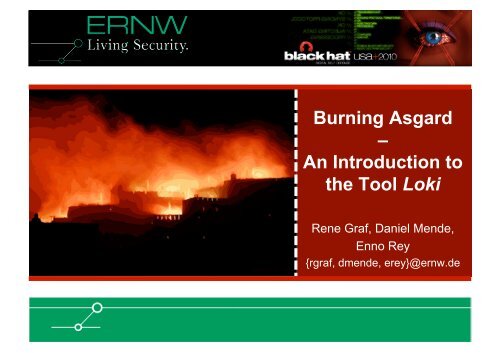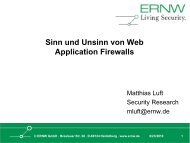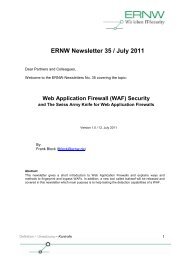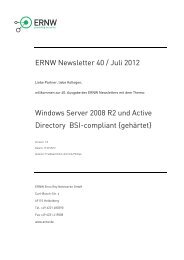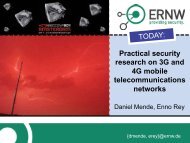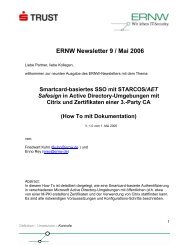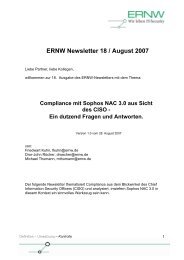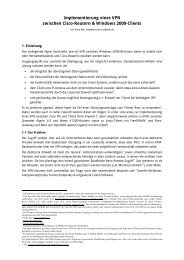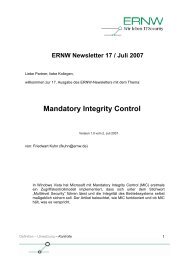Burning Asgard - An Introduction to the Tool Loki - ERNW
Burning Asgard - An Introduction to the Tool Loki - ERNW
Burning Asgard - An Introduction to the Tool Loki - ERNW
Create successful ePaper yourself
Turn your PDF publications into a flip-book with our unique Google optimized e-Paper software.
<strong>Burning</strong> <strong>Asgard</strong><br />
–<br />
<strong>An</strong> <strong>Introduction</strong> <strong>to</strong><br />
<strong>the</strong> <strong>Tool</strong> <strong>Loki</strong><br />
Rene Graf, Daniel Mende,<br />
Enno Rey<br />
{rgraf, dmende, erey}@ernw.de
Who we are<br />
� Old-school network geeks.<br />
� Working as security<br />
researchers for Germany<br />
based <strong>ERNW</strong> GmbH.<br />
� Fiddling around with<br />
devices and pro<strong>to</strong>cols<br />
makes <strong>the</strong> majority of our<br />
days.<br />
Some of our colleagues at this year’s TROOPERS<br />
2
<strong>ERNW</strong> GmbH<br />
� Heidelberg based security consulting and assessment<br />
company with currently 18 employees (as of july 2010).<br />
� Independent<br />
� Deep technical knowledge<br />
� Structured (assessment) approach<br />
� Business reasonable recommendations<br />
� We understand corporate<br />
� Blog: www.insinua<strong>to</strong>r.net<br />
� Conference: www.troopers.de<br />
3
Agenda<br />
� Why LOKI<br />
� The <strong>Tool</strong><br />
� Advanced Stuff<br />
4
What do you see here?<br />
5
Now…<br />
� This ends up in sec_assessmentreports<br />
like “can <strong>the</strong>oretically be<br />
attacked, should be cured”.<br />
� Is it going <strong>to</strong> be cured?<br />
� Well… it’s only <strong>the</strong>oretical, isn’t it?<br />
6
Do we need a game changer again?<br />
� Would <strong>the</strong>y care (more) if it wasn’t just<br />
<strong>the</strong>oretical? ;-)<br />
� Did Cain&Abel change <strong>the</strong> way<br />
“<strong>the</strong>oretical vulnerabilities” were<br />
perceived?<br />
� Sure, it did…<br />
7
Here comes…<br />
8
For completeness’ sake<br />
� What’s currently out <strong>the</strong>re<br />
� IRPAS (only “discovery” for routing pro<strong>to</strong>cols)<br />
� Yersinia (mainly Layer 2)<br />
� Hping<br />
� Nemesis (OSPF module was never implemented)<br />
� Scapy (very powerful, still requires quite some $PROT knowledge)<br />
9
Back on track<br />
� What does LOKI provide?<br />
� GUI<br />
� Written in Python<br />
� Modular architecture<br />
� Lots of pro<strong>to</strong>cols implemented<br />
(already) that none of <strong>the</strong> o<strong>the</strong>r<br />
<strong>to</strong>ols have.<br />
� Also a new version of <strong>the</strong><br />
mplstun is included.<br />
10
LOKI – Overview / <strong>Introduction</strong><br />
� Architecture<br />
� (Main) Modules<br />
� GUI<br />
<strong>Loki</strong> as depicted on an<br />
18th century Icelandic manuscript<br />
© Wikipedia<br />
11
Architecture<br />
The main program:<br />
� The module API<br />
� Library extensions<br />
12
Legerdemains LOKI has learned so far<br />
� Pro<strong>to</strong>cols<br />
� ARP<br />
� HSRP, HSRPv2<br />
� RIP<br />
� BGP<br />
� OSPF<br />
� EIGRP [not-yet-<strong>to</strong>-be-released due <strong>to</strong> legal blur]<br />
� WLCCP [not-yet-<strong>to</strong>-be-released due <strong>to</strong> legal blur]<br />
� VRRP, VRRPv3<br />
� BFD<br />
� LDP<br />
� MPLS (re-labeling, tunnel interface)<br />
13
Attacks<br />
� Attacks implemented so far<br />
� ARP<br />
� Arp spoofing<br />
� Arp scanning<br />
� Arp flooding<br />
� BFD<br />
� DoS of existing BFD session<br />
� BGP<br />
� NLRI injection<br />
� EIGRP<br />
� EIGRP TLV injection<br />
� Au<strong>the</strong>nticated / Unau<strong>the</strong>nticated DoS<br />
� HSRP, HSRPv2<br />
� IP address take-over<br />
14
Attacks – 2<br />
� Attacks implemented so far [cont]<br />
� LDP<br />
� Injection of label mapping messages<br />
� MPLS<br />
� Rewrite of MPLS labels<br />
� MPLS-VPN enabled network stack<br />
� OSPF<br />
� Injection of LSAs<br />
� MD5 au<strong>the</strong>ntication cracking<br />
� RIP<br />
� Route injection<br />
� TCP-MD5<br />
� RFC2385 au<strong>the</strong>ntication cracking
Attacks – 3<br />
� Attacks implemented so far [cont]<br />
� VRRP, VRRPv3<br />
� IP Address take-over<br />
� WLCCP<br />
� Winning <strong>the</strong> WDS master election<br />
� Sniffing and cracking of infrastructure au<strong>the</strong>ntication (asleap)<br />
� Sniffing and generating of CTK nonce and key<br />
� Sniffing and decryption of client PMK
GUI<br />
� Based upon GTK.<br />
� Main program implements main-<br />
and preference window.<br />
� Module GUIs based on GLADE files<br />
and are parsed on load.<br />
With <strong>the</strong> increasing adoption of Macs,<br />
we thought a GUI might me a good idea ;)<br />
17
GUI
Ok, so what can we do with it?<br />
� Simple answer: attack infrastructure pro<strong>to</strong>cols ;-)<br />
� To give you an idea, some short discussion of attacks<br />
against routing pro<strong>to</strong>cols.<br />
19
Routing pro<strong>to</strong>cols<br />
� Different flavors<br />
� Interior gateway pro<strong>to</strong>cols (“within an AS”)<br />
� RIP, EIGRP, OSPF, IS-IS<br />
� Exterior gateway pro<strong>to</strong>cols (“between different ASs”)<br />
� BGP<br />
� Different ways <strong>to</strong> perform <strong>the</strong>ir work<br />
� Distance vec<strong>to</strong>r pro<strong>to</strong>cols<br />
� RIP, EIGRP<br />
� Link state pro<strong>to</strong>cols<br />
� OSPF, IS-IS<br />
� Path vec<strong>to</strong>r pro<strong>to</strong>cols<br />
� BGP<br />
20
Attacking routing pro<strong>to</strong>cols<br />
� In <strong>the</strong> past quite some discussion of attacks against BGP<br />
� DEF CON 2008 (Kapela/Pilosov)<br />
� Black Hat Europe 2009 (Mende/Rey)<br />
� See: http://www.ernw.de/content/e7/e181/e1309/download1357/<strong>ERNW</strong>_BlackHatEurope09_all_your_packets_ger.pdf<br />
� Youtube / Pakistan incident<br />
� China Telecom incident (March 2010)<br />
� Not <strong>to</strong>o much discussion of attacks against IGPs<br />
� RFC 4593 (Oct 2006) Generic Threats <strong>to</strong> Routing Pro<strong>to</strong>cols<br />
� IETF Draft (Jun 2006) on OSPF Security Vulnerabilities <strong>An</strong>alysis<br />
� Presentation (Roecher/Auffret) at IT Underground 2007<br />
� See: http://www.ernw.de/content/e7/e181/e520/download523/ospf-sec_02_dr_ger.pdf<br />
� IETF working group on RPSec concluded work some time ago.<br />
21
Attacking IGPs – Impact<br />
� RFC 4593:<br />
“We assume that <strong>the</strong> most common goal of an adversary deliberately<br />
attacking routing is <strong>to</strong> cause inter-domain routing <strong>to</strong> malfunction. A<br />
routing malfunction affects data transmission such that traffic follows<br />
a path […] o<strong>the</strong>r than one that would have been computed by <strong>the</strong> routing<br />
pro<strong>to</strong>col if it were operating properly[…]<br />
As a result of an attack, a route may terminate at a router o<strong>the</strong>r than<br />
<strong>the</strong> one that legitimately represents <strong>the</strong> destination address of <strong>the</strong><br />
traffic, or it may traverse routers o<strong>the</strong>r than those that it would<br />
o<strong>the</strong>rwise have traversed. In ei<strong>the</strong>r case, a routing malfunction may<br />
allow an adversary <strong>to</strong> wiretap traffic passively, or <strong>to</strong><br />
engage in man-in-<strong>the</strong>-middle (MITM) active attacks,<br />
including discarding traffic (denial of service).”<br />
� So it’s basically about<br />
� Large scale traffic redirection/interception<br />
� Denial-of-Service<br />
22
OSPF – Route Injection<br />
� Open Shortest Path First<br />
� Most widely deployed routing pro<strong>to</strong>col in large networks<br />
� Link state pro<strong>to</strong>col (“tell world about neighbors”)<br />
� Impact of route injection might<br />
depend on exact design/config.<br />
� Has some built-in protection<br />
(“OSPF fight back”). Which does<br />
not protect against attackers<br />
(only against misconfig).<br />
23
EIGRP – Route Injection<br />
� Enhanced Interior Gateway Routing Pro<strong>to</strong>col<br />
� Distance Vec<strong>to</strong>r Pro<strong>to</strong>col (“tell neighbors about world”)<br />
� Cisco proprietary<br />
� Hence our concerns as for release of <strong>the</strong> module.<br />
� Quite some deployment in enterprise networks (“Cisco<br />
shops”)<br />
� Mostly “fire+forget” implementations.<br />
� Some security discussion back in 2005.<br />
� Nothing more happened since <strong>the</strong>n as for EIGRP attacks.<br />
24
OSPF – Attacking Au<strong>the</strong>ntication<br />
� MD5 key based au<strong>the</strong>ntication<br />
part of standard.<br />
� Some cleartext auth variants can<br />
be found (Windows 2KSRV… )<br />
� Overall good protection… if<br />
deployed correctly<br />
� We know one very large corporate<br />
network with OSPF key “highsecure”…<br />
� Can be attacked/cracked… ;-)<br />
DEMO<br />
25
Mitigating Controls<br />
Going with (only) au<strong>the</strong>ntication and passive-interfaces provides “good enough<br />
security” for most networks!<br />
You can contact us for config templates…<br />
26
Advanced Stuff<br />
27
Some more sophisticated modules<br />
� VRRP<br />
� BFD<br />
� LDP<br />
28
VRRP – Overview<br />
� “First hop redundancy pro<strong>to</strong>col”<br />
� Standardized (in contrast <strong>to</strong> Cisco-proprietary HSRP)<br />
� First described in RFC 2338, updated in RFC 3678.<br />
� In <strong>the</strong> interim (IPv6 capable) VRRPv3, specified in RFC 5798.<br />
� Initially gained some ground in<br />
Firewall-1_on_Nokia_boxes deployments some years ago.<br />
29
VRRP overview<br />
0 .20<br />
30
VRRP – Some additional notes<br />
� From RFC3768:<br />
The priority field specifies <strong>the</strong> sending VRRP router's priority for<br />
<strong>the</strong> virtual router. Higher values equal higher priority. This field<br />
is an 8 bit unsigned integer field.<br />
The priority value for <strong>the</strong> VRRP router that owns <strong>the</strong> IP address(es)<br />
associated with <strong>the</strong> virtual router MUST be 255 (decimal).<br />
� a priority of 255 is not available<br />
(at least on Cisco devices)…<br />
� Really? ;-))<br />
31
Demo<br />
32
Mitigating Controls – Remarks<br />
� VRRP Auth<br />
� From RFC3768:<br />
VRRP does not currently include any type of au<strong>the</strong>ntication. Earlier<br />
versions of <strong>the</strong> VRRP specification included several types of<br />
au<strong>the</strong>ntication ranging from none <strong>to</strong> strong. Operational experience<br />
and fur<strong>the</strong>r analysis determined that <strong>the</strong>se did not provide any real<br />
measure of security.<br />
33
BFD – How it works<br />
� From RFC5882:<br />
The Bidirectional Forwarding Detection pro<strong>to</strong>col provides a<br />
liveness detection mechanism that can be utilized by o<strong>the</strong>r network<br />
components for which <strong>the</strong>ir integral liveness mechanisms are ei<strong>the</strong>r<br />
<strong>to</strong>o slow, inappropriate, or nonexistent.<br />
� Yet ano<strong>the</strong>r keep alive mechanism<br />
� Uses IP and UDP (on port 4784) for transport.<br />
� Provides failover detection in about 100ms.<br />
34
BFD<br />
35
LOKI is “work in progress”<br />
� Upcoming features<br />
� ISIS (Intermediate System Intermediate System)<br />
� GLBP (Gateway Load Balancing Pro<strong>to</strong>col)<br />
� SNMP – Our SNMP framework will be integrated<br />
� To complete <strong>the</strong> suite:<br />
� VTP, DTP, STP, DHCP [albeit already<br />
present in yersinia]<br />
� Maybe o<strong>the</strong>r infrastructure pro<strong>to</strong>cols<br />
� Direct suggestions <strong>to</strong>: dmende@ernw.de<br />
� Bug Fixes (of course ;-)<br />
36
Ragnarök begins…<br />
� LOKI project page<br />
� https://c0decafe.de/loki.html<br />
� After BH also available for<br />
download at www.ernw.de<br />
� Current version: 0.2.4<br />
� Available as<br />
� Source c0de<br />
� Ubuntu 10.04 (current) packages<br />
� Gen<strong>to</strong>o eBuild<br />
37
Conclusions<br />
� There’s a new kid in <strong>the</strong> infrastructure attack block.<br />
“From <strong>the</strong>oretical <strong>to</strong> practical, once more.”<br />
� Protect your infrastructure!<br />
� When implementing controls, always think about “security<br />
benefit vs. operational impact ratio”.<br />
Do not do everything some smart whitepapers<br />
tell you / recommend.<br />
� Go out & write your own <strong>Loki</strong> modules<br />
� … and have fun at Black Hat, of course ;-)<br />
38
There’s never enough time…<br />
THANK YOU… ...for yours!<br />
39
Credits<br />
� Olli for contributing <strong>to</strong> WLCCP research and module<br />
� Flo for all <strong>the</strong> awesome eye-candy<br />
40
Additional Info<br />
� Download slides and <strong>to</strong>ols later<br />
this day at www.ernw.de<br />
� Subscribe <strong>to</strong> our blog<br />
www.insinua<strong>to</strong>r.net<br />
� Visit www.troopers.de or follow<br />
@WEareTROOPERS <strong>to</strong> stay up-<strong>to</strong>date<br />
on TROOPERS conference<br />
Your next TROOPERS boot camp is scheduled for<br />
14-18 March 2011 @ Heidelberg, Germany.<br />
41
Final Wisdom<br />
Whatever you do... always remember <strong>the</strong> following two:<br />
� Ross Callon in RFC 1925:<br />
“Some things in networking can never be fully unders<strong>to</strong>od by<br />
someone who nei<strong>the</strong>r builds commercial networking equipment nor<br />
runs an operational network.“<br />
� If really interested in this stuff get your hands on some devices ;-)<br />
� Simplicity Principle from RFC 3439<br />
42


